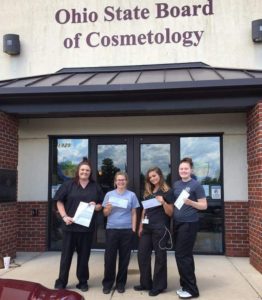The Ohio Department of Education recently added 49 industry-recognized credentials to its list of those available to interested high school students in the state. Ohio’s secondary school students can earn credentials in one of 13 career fields — ranging from agriculture/environmental systems to transportation — to help them better understand and prepare for in-demand jobs and careers. To learn more about the credentialing program in Ohio schools, we contacted Andrea Zaph, principal of the STEM Academy at Collins Career Technical Center in Chesapeake, in far southern Ohio’s Lawrence County:
Q: Give us an overview of the industry-recognized credential program available to Ohio high school students.

A: Earning an industry-recognized credential is an integral part of one of the graduation pathways available to Ohio high school students. Students can access this path to a diploma by receiving an acceptable score on the WorkKeys Assessments and a credential from the approved list of the Ohio Department of Education (ODE).
Q: ODE recently added 49 credentials that students can work toward. Why is this important?
A: ODE has a process in place that additional credentials can be submitted for approval to be added to the industry-recognized credential list. The list is reviewed on an annual basis to verify that the credentials are applicable in an ever-changing work environment in the state of Ohio. The list is comprehensive for all career fields.
Q: Why is such credentialing important to today’s students, and to employers?
A: Credentialing provides today’s students with an advantage over other job candidates when applying for open positions. Credentialing also allows students to participate in learning that is authentic and relevant to their career fields. They can know long before high school graduation if the career technical program they have selected is the right career choice for them.
Credentialing is important to employers because the process supplies qualified employees who already possess a working knowledge of the career field. The process saves employers valuable time and money due to shortened training periods.
Q: How are credentialing classes integrated into the school curriculum? How do students meet state education standards when working toward a credential?

A: Career technical standards and competencies for each career field are aligned with industry standards. This allows for effective alignment with industry-recognized credentials. The industry standards and credential learning objectives are integrated into school curriculum that is already focused on the career technical state education standards and competencies.
Q: Are credentialing programs offered only at career centers?
A: Credentialing programs are offered at career centers and comprehensive high schools. Programming at a comprehensive high school goes through an approval process with a nearby career technical center/joint vocational school district.
Q: In general, do industry partners supply many of the teachers for these programs, or are the classes taught by school staff members?
A: Career technical programs are taught by high school licensed staff members who align their curriculum with industry standards. The industry-recognized credential assessment is then utilized to measure student competency within a career technical program. In very few instances, outside industry partners may supply instruction for a specific industry-recognized credential (i.e. OSHA 10, a job-safety awareness class).
Q: On average, how long does it take to earn a credential? Does it require just in-class time, or on-site training, or both?
A: The time required to earn a credential varies widely based on the specific credential. The approved credentials are classified by a points system. The credentials range from 1 to 12 points. Generally speaking, credentials ranked higher in points are those with more content and take more time to earn. Students utilizing the credential pathway to graduation must earn credentials that equal at least 12 points.
Q: Are extra fees assessed to students who take classes to earn a credential through an Ohio high school or career center?
A: There are no extra fees assessed to students who take classes to earn a credential.
Q: Can a student’s work toward a credential also earn college credit?
 A: Students working toward a credential may also earn college credit through College Credit Plus, articulated credit (Career-Technical Assurance Guide, or CTAG) or Advanced Placement (AP) credit.
A: Students working toward a credential may also earn college credit through College Credit Plus, articulated credit (Career-Technical Assurance Guide, or CTAG) or Advanced Placement (AP) credit.
Q: What are WorkKeys, and how do they figure into the credentialing program?
A: The graduation pathway requirements include both an industry-recognized credential(s) equaling at least 12 points and a score on the WorkKeys Assessments totaling at least 13 points. The WorkKeys Assessments measure foundational workplace skills that can affect job performance and career success. The assessments include Applied Math (critical thinking, mathematical reasoning and problem solving); Graphic Literacy (locating, synthesizing and using information from workplace graphics); and Workplace Documents (written text comprehension).
Q: Is there anything else you can share with us about Ohio’s credentialing program?
A: The credentialing program allows students and educators to concentrate on the skills and knowledge applicable to the student’s chosen career field. This leads to students being more engaged, and increased engagement leads to student success.
The creation of the credential pathway for graduation is opening up opportunities for students so they can access gainful employment earlier and jumpstart their futures, whether it be in a career or postsecondary education.
